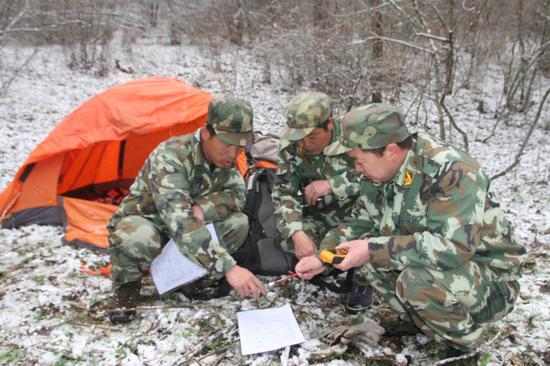Giant panda conservation efforts lead to population growth

Researchers collected giant panda feces during the fourth giant panda census. (Photo provided to chinadaily.com.cn)
The population of wild giant pandas has increased from around 1,100 in the 1980s to nearly 1,900 as of last year. China's efforts in conserving its population of giant pandas resulted in the species being downgraded by the International Union for the Conservation of Nature from endangered to vulnerable in 2016.
The nation's protected area for giant panda habitats has expanded from 1.39 million hectares in the 1980s to 2.58 million hectares.
The establishment of the Giant Panda National Park in 2021, spanning the provinces of Sichuan, Shaanxi and Gansu, ensures the protection of some 70 percent of the wild habitat of giant pandas. Thanks to careful monitoring, the number of giant pandas captured on camera and encountered in the wild has increased, according to the National Forestry and Grassland Administration.
While giant panda lovers celebrate the continuous growth in population of China's national treasure, concerns were raised in an article by the New York Times this month. Citing expert comments from 2006 and 2010, it said that the methods used by China to survey the wild panda population were "not ideal" and that "China keeps its methodology a secret".
There have been four giant panda censuses since the 1970s, with the most recent completed in 2015, a full five years later than the sources cited by the NYT.

Researchers recorded data during the fourth giant panda census. (Photo provided to chinadaily.com.cn)
"Population assessment is a challenge in wildlife conservation research, especially for forest dwelling animals like giant pandas, which are often difficult to directly observe and count, and can only be assessed through collecting relevant trace information," said Xu Weihua, vice-president of the Institute of National Parks.
In the third national giant panda survey that started in 1999 and the fourth that started in 2011, researchers set up survey lines every two square kilometers in key areas within the panda distribution range. In areas with fewer pandas, survey lines were set up every six sq km.
"This is a high-intensity information gathering density. Surveyors collected data on panda feces, bite marks, and used distance and bite mark differentiation methods for a comprehensive analysis to evaluate the population of giant pandas nationwide," Xu said, noting that both methods are scientifically validated and effective for conducting surveys on wild populations.
The distance differentiation method involves calculating the distance between panda trace points obtained during field surveys, such as feces, footprints and hair, to determine if they come from the same panda, thereby confirming the number of pandas in the area.
"Giant pandas are solitary animals, and except during mating and seasonal vertical migration periods, their movement within a certain time frame is limited and stable. By determining the home range and dispersal ability of giant pandas, we can confirm whether trace points belong to the same panda. If the distance between two trace points exceeds the normal activity range of a giant panda, it is preliminarily determined that there is more than one panda in the area," said Xu explaining the scientific basis of this method.



